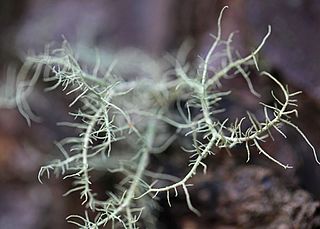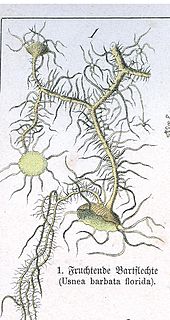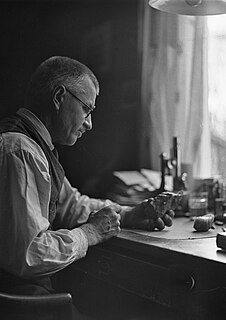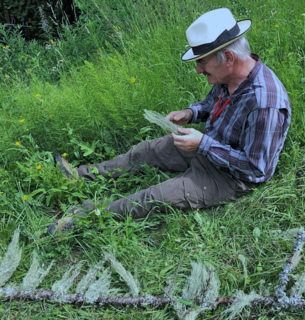
Usnea is a genus of mostly pale grayish-green fruticose lichens that grow like leafless mini-shrubs or tassels anchored on bark or twigs. The genus is in the family Parmeliaceae. It grows all over the world. Members of the genus are commonly called old man's beard, beard lichen, or beard moss.

The Parmeliaceae is a large and diverse family of Lecanoromycetes. With over 2700 species in 71 genera, it is the largest family of lichen-forming fungi. The most speciose genera in the family are the well-known groups: Xanthoparmelia, Usnea, Parmotrema, and Hypotrachyna.

Usnea longissima, known by the name old man's beard or Methuselah's beard lichen, is a lichen in the family Parmeliaceae.
Hildur Krog was a Norwegian botanist.
Józef Motyka was a Polish botanist and lichenologist.

Usnea articulata, commonly known as the string-of-sausage lichen, is a pale greenish-grey, densely branched lichen with a prostrate or pendant growth form. It grows on bark, on branches and twigs, and is often unattached to a branch and merely draped over it. It grows up to 100 cm (40 in) in length.

Lecanoric acid is a chemical produced by several species of lichen. Lecanoric acid is classified as a polyphenol and a didepside and it functions as an antioxidant. The acid is named after the lichen Lecanora. The acid has also been isolated from Usnea subvacata, Parmotrema stuppuem, Parmotrema tinctorum,Parmotrema grayana, Xanthoparmelia arida and Xanthoparmelia lecanorica. A related compound, 5-chlorolecanoric acid, is found in some species of Punctelia.

Edvard August Vainio was a Finnish lichenologist. His early works on the lichens of Lapland, his three-volume monograph on the lichen genus Cladonia, and, in particular, his study of the classification and form and structure of lichens in Brazil, made Vainio renowned internationally in the field of lichenology.

Graphis plumierae is a species of script lichen in the family Graphidaceae. It was described as new to science in 1915 by Finnish mycologist Edvard Vainio. The type was collected in Gourbeyre, Guadeloupe. In 2016, G. plumierae was reported from Portugal, which was also a new occurrence for Europe.

Usnea is a species of beard lichen in the family Parmeliaceae. It was described as a new species in 1925 by Finnish lichenologist Edvard August Vainio. The lichen has a richly branched thallus, and the branches have depressions and foveolae. It is widely distributed in Europe.

Usnea florida is a species of beard lichen in the family Parmeliaceae. It was first described by Carl Linnaeus in his 1753 work Species Plantarum. German botanist Friedrich Heinrich Wiggers transferred it to the genus Usnea in 1780. It is considered a threatened or vulnerable species in several European countries.

Usnea fulvoreagens is a species of beard lichen in the family Parmeliaceae. It was first described by Finnish lichenologist Veli Räsänen in 1931 as a variety of Usnea glabrescens. He raised it to distinct species status in 1935. The lichen has a shrubby thallus that is richly branched, and bases that are blackened. The presence of norstictic acid is often used to differentiate this species from other similar species. It has a widespread distribution in Europe.
Usnea glabrescens is a species of beard lichen in the family Parmeliaceae. It grows on bark, has a shrubby thallus with a blackened base, and a thick cortex. Several chemotypes of this species have been reported. The lichen is widely distributed in Europe.

Dolichousnea is a genus of fruticose lichens in the family Parmeliaceae. It has three species. The widely distributed type species, Dolichousnea longissima, is found in boreal regions of Asia, Europe, and North America.

Allographa leptospora is a species of script lichen in the family Graphidaceae. The lichen was first formally described in 1921 by Finnish lichenologist Edvard August Vainio as Graphis leptospora. The type specimen was collected in 1904 by German botanist Carl Curt Hosseus on Doi Suthep, where it was found growing on tree bark. Hosseus sent this and other lichens collected from Thailand to Vainio for identification. Robert Lücking and Klaus Kalb transferred it to the genus Allographa in 2018. In 2016, the lichen was reported from the Sintra Mountains, Portugal, which was its first documented occurrence in Europe.

Veli Johannes Paavo Bartholomeus Räsänen was a Finnish lichenologist.
Usnea vainioi is a rare species of beard lichen in the family Parmeliaceae found in the southeastern United States. It was described as a new species in 1936 by Polish lichenologist Józef Motyka. The specific epithet honours Finnish lichenologist Edvard August Vainio. The lichen contains diffractaic acid as the main secondary compound.

Philippe Clerc is a Swiss lichenologist. A Festschrift was dedicated to him in 2020, on the occasion of his retirement from the Conservatory and Botanical Garden of the City of Geneva, where he worked from 1993 to 2020. Clerc is an authority on the beard lichens, and has had nearly 100 publications on this and other topics, such as the lichen flora of Switzerland.
Josef Anders was a Czech botanist and lichenologist.
Phylloblastia is a genus of foliicolous (leaf-dwelling) lichens in the family Verrucariaceae. The genus was circumscribed in 1921 by Finnish lichenologist Edvard August Vainio, with Phylloblastia dolichospora assigned as the type species.













